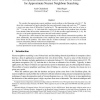Free Online Productivity Tools
i2Speak
i2Symbol
i2OCR
iTex2Img
iWeb2Print
iWeb2Shot
i2Type
iPdf2Split
iPdf2Merge
i2Bopomofo
i2Arabic
i2Style
i2Image
i2PDF
iLatex2Rtf
Sci2ools
FOCS
2004
IEEE
2004
IEEE
An Optimal Randomised Cell Probe Lower Bound for Approximate Nearest Neighbour Searching
We consider the approximate nearest neighbour search problem on the Hamming cube {0, 1}d. We show that a randomised cell probe algorithm that uses polynomial storage and word size dO(1) requires a worst case query time of (log log d/ log log log d). The approximation factor may be as loose as 2log1- d for any fixed > 0. Our result fills a major gap in the study of this problem since all earlier lower bounds either did not allow randomisation [7, 21] or did not allow approximation [6, 3, 19]. We also give a cell probe algorithm that proves that our lower bound is optimal. Our proof uses a lower bound on the round complexity of the related communication problem. We show, additionally, that considerations of bit complexity alone cannot prove any nontrivial cell probe lower bound for the problem. This shows that the "richness technique" [23] used in a lot of recent research around this problem would not have helped here. Our proof is based on information theoretic techniques...
Cell Probe Algorithm | FOCS 2004 | Lower Bound | Randomised Cell Probe | Theoretical Computer Science |
Related Content
| Added | 20 Aug 2010 |
| Updated | 20 Aug 2010 |
| Type | Conference |
| Year | 2004 |
| Where | FOCS |
| Authors | Amit Chakrabarti, Oded Regev |
Comments (0)

